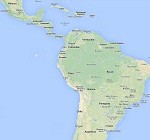CELAC summit in Cuba
The second summit meeting of the Community of the Latin American and Caribbean countries (CELAC) was held in Havana, Cuba, on 28-29 January. The President of the Organisation of American States (OAS) and the UN Secretary General were present at the summit.
Leaders of CELAC signed an accord at the summit declaring Latin America and the Caribbean as a Zone of Peace, and agreed to settle any conflicts peacefully. The main focus was on tackling the common issues of poverty, illiteracy and healthcare.
Formed in December 2011, CELAC brings together all the 33 countries of the region as a counterweight to the U.S.-dominated and Washington-based OAS, which excludes Cuba.
CELAC does not have any immediate ambitious plans for regional integration, unlike other sub-regional groups such as Mercosur, which focus on free trade and economic integration. But CELAC provides a platform and voice for the region without the interference and intrusive presence of the U.S; it symbolises the new Latin America, which has become more autonomous and assertive in its foreign policy.
India opened a dialogue and held a meeting with CELAC foreign ministers in New Delhi in August 2012. The meeting called for a strategic partnership between India and CELAC, and increased cooperation in trade, investment, energy, agriculture, education, science and technology, among other sectors. The second meeting, scheduled to take place during the Havana summit, was cancelled.
The two sides had agreed to set up an India-CELAC Business Council and an India-CELAC CEOs forum. But there has been no follow-up action so far. Meanwhile, China has created a China-CELAC Forum, which was announced at the Havana summit. The first meeting of the forum will take place in China in 2014.
Pacific Alliance Summit
At the meeting of the Pacific Alliance held in February in Cartagena in Colombia, the four members – Colombia, Mexico, Peru and Chile – agreed to remove tariffs on 92% of the items traded among themselves, by 2015. The remaining 8% consists of goods considered as sensitive, such as agro-products. The elimination of tariffs on these 8% will take seven years. The four also agreed to create a fund to finance infrastructure investments within the member countries, and establish a joint system to monitor and control the price of medicines.
The Pacific Alliance represents 36% of Latin America’s GDP and half of its exports. The group’s goals of integration include free trade, visa-free travel, a common stock exchange, and even common diplomatic representation.
Costa Rica signed an agreement to join the Pacific Alliance by the end of 2014. Panama and Guatemala have also expressed an interest in membership. India was admitted as an observer, along with a number of other countries, at the Cartagena summit. India has a preferential trade agreement with Chile and is considering similar agreements with the other Alliance member countries.
Elections in Costa Rica and El Salvador
Costa Rica and El Salvador both held elections on February 2. In both countries, the centre-left candidates got the maximum number of votes, but no candidate got the minimum required percentage of votes.
Costa Rica is the most peaceful and prosperous country in Central America, while El Salvador grapples with serious issues of crime, violence, drug trafficking and poverty. El Salvador has suffered terrible violence, with more than 75,000 killed and 500,000 displaced in the 12-year long civil war which ended in 1992.
In El Salvador, the governing Farabundo Marti National Liberation Front’s (FMLN) Salvador Sánchez Cerén came close to a win with 48.92%. He is a leftist ex-guerrilla commander and was vice president in the outgoing government. In the March 9 runoff, he faced Norman Quijano of the right-wing Nationalist Republican Alliance (ARENA), who was second with 38.95%.
The elections in Costa Rica threw up a surprise: Luis Guillermo Solís of the PAC (Citizens’ Action Party) got the maximum votes among the 12 candidates. Solis, a centre-left academician and former official of the foreign ministry, is an outsider to the country’s political establishment and has never held any elected position. He fought the elections on an anti-corruption platform. The outgoing PLN (National Liberation Party) government was plagued with corruption scandals. Solís got 30.6% of the votes and will fight the second round of elections against Johnny Araya of the ruling PLN, who got 29.7%. If Solis wins the second round on April 6, he will put Costa Rica in the list of Latin American countries ruled by the Left.
Ambassador Viswanathan is Distinguished Fellow, Latin America Studies, Gateway House. He is the former Indian Ambassador to Argentina, Uruguay, Paraguay and Venezuela, and Consul General in Sao Paulo.
This article was exclusively written for Gateway House: Indian Council on Global Relations. You can read more exclusive content here.
For interview requests with the author, or for permission to republish, please contact outreach@gatewayhouse.in.
© Copyright 2014 Gateway House: Indian Council on Global Relations. All rights reserved. Any unauthorized copying or reproduction is strictly prohibited.


